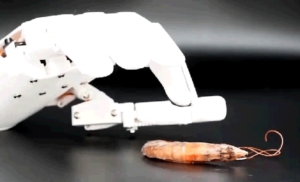Researchers at North Carolina State University have developed a robotic gripper that is gentle enough to pick up a drop of water, yet strong enough to lift an object weighing 6.4 kilograms. The device is also adept enough to fold cloth and can pick up microfilms that are 20 times thinner than a human hair.
In addition to potential manufacturing applications, the researchers also integrated the device with technology that allows the gripper to be controlled by electrical signals generated by forearm muscles, demonstrating its potential for use in robotic prostheses.
“Due to the trade-off between strength, precision and delicacy, it is difficult to develop a single soft gripper capable of handling ultra-soft, ultra-thin and heavy objects,” said Jie Yin, a professor of mechanical and aerospace engineering at North Carolina State. “Our design achieves an excellent balance of these qualities.”
The design of the new grips is based on the art of kirigami, which involves both cutting and folding two-dimensional sheets of material to form three-dimensional shapes. The new design is able to achieve high strength and delicacy because it distributes the force throughout the structure of the gripper.
“The strength of robotic grippers is generally measured by the payload-to-weight ratio,” Yin said. “Our grippers weigh 0.4 grams and can lift up to 6.4 kilograms. That’s a load-to-weight ratio of about 16,000. This is 2.5 times higher than the previous record for a load-to-weight ratio of 6,400. Characteristics of gentleness and precision indicate the strength of the grippers for many applications.”
Another advantage of the new technology is that its attractive features are mainly due to its construction, not the materials used to make the grippers. In practical terms, this means you can make grippers from biodegradable materials, such as sturdy plant leaves. This can be particularly useful in applications where you only want to use the grippers for a limited time, such as when handling food or biomedical materials. Experiments have shown that grippers can be used to handle sharp medical objects – such as needles.
The researchers also integrated the gripper with a myoelectric prosthesis, meaning the prosthesis is controlled by muscle activity. “This gripper provided advanced functionality for tasks that are difficult to perform with existing prostheses, such as locking certain types of zippers, picking up a coin, and so on,” said Helen Huang, a professor in the Joint Department of Biomedical Engineering at the University of North Carolina at Chapel Hill.
“The new gripper cannot replace all the functions of existing prosthetic hands, but it can be used to supplement their other functions,” Huang said. “And one of the advantages of kirigami grippers is that you don’t have to replace or upgrade existing motors used in robotics. By using grippers, you can just take advantage of an existing motor.”
In a test of concept, the researchers showed that kirigami grippers could be used in conjunction with a myoelectric prosthesis to turn the pages of a book and pluck grapes from grapes.
“We think the gripper design has potential applications in fields ranging from robotics and food processing to the pharmaceutical and electronics industries,” Yin said. “We look forward to working with industry partners to find ways to leverage the technology.”
Source: Science Daily

